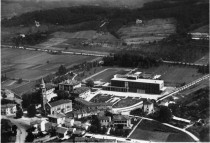Trg Ivana Roba 3a
5290 Šempeter pri Gorici
T: +386 (0)5 335 10 00
F: +386 (0)5 335 10 07
E: info@sempeter-vrtojba.si
Official Hours:
Monday and Friday:
8.00 a.m.-12.00 a.m.
Wednesday:
8.00 a.m.-12.00 a.m. and
2.00 p.m.-4.30 p.m.
VAT no.: SI 44857390
Registration number: 1358227


Short history
Municipality of Šempeter-Vrtojba was established in 1998.
For centuries Šempeter pri Gorici and Vrtojba remained suburbs of the town of Gorizia with which they formed a whole. Up to the incorporation of the Primorska region into the native country in 1947 the two places remained almost exclusively rural localities and suppliers of vegetables and other farm produce to Gorizia. Since 1947 there have been extreme changes in both the economic and educational structures due to the introduction of industrial, commercial and other services and social activities (hospital, schools…). During their long history both places, went through peaceful as well as through agitated periods, devastating war periods included.
Šempeter pri Gorici
The area of the present-day Šempeter was peopled already in the 12th Century BC. During the Roman times there was a settlement named Torgium which was destructed around the year 100. In the written documents the place »De sancto Pietro« is first mentioned around the year 1200 in the list of estates belonging to the Counts of Gorizia. Middle Ages documents refer to the place as »prope Goritiam« – near Gorizia – and that part of its name has remained unchanged up to present day.
Šempeter was a parish as early as in 1425 when the construction of a new church begun. The only remains of that church are represented today by consoles in the shape of human heads incorporated in the edge of the wall surrounding the church.
Šempeter and Vrtojba remained typical settlements in the vicinity of a town and their religious, economic and social images were closely linked to the town’s necessities. Šempeter knew no emigration, a common feature of the neighbouring villages.
Postcard of Šempeter from 19. century.
 In May 1915 Italy declared war on Austria-Hungary and the day after the declaration in the near vicinity of the two places the Isonzo Front began. The first grenades reached Šempeter and its surroundings in July 1916, and during the 6th Battle of the Isonzo inhabitants of both Šempeter and Vrtojba were forced into exile, since their homes were situated directly in the front line. The Italians occupied the places, but in Šempeter they did not reach further the railway and the slopes of the Sv. Marko hill. The two places were destroyed in the cross-fire of the enemy artilleries. After the complete devastation a general recovery began in 1918 and Šempeter was restored according to plans made by renowned architect Maks Fabiani.
In May 1915 Italy declared war on Austria-Hungary and the day after the declaration in the near vicinity of the two places the Isonzo Front began. The first grenades reached Šempeter and its surroundings in July 1916, and during the 6th Battle of the Isonzo inhabitants of both Šempeter and Vrtojba were forced into exile, since their homes were situated directly in the front line. The Italians occupied the places, but in Šempeter they did not reach further the railway and the slopes of the Sv. Marko hill. The two places were destroyed in the cross-fire of the enemy artilleries. After the complete devastation a general recovery began in 1918 and Šempeter was restored according to plans made by renowned architect Maks Fabiani.

Aircraft photograph of Šempetra pri Gorici in 1930 (source: www.asso4stormo.it)
The two places suffered also during World War Two. In the autumn of 1943 they were on the spot of the so-called Front of Gorizia. In 1947 the process of industrialization started and since then farmland has been continuously shrunk on account of industrial and residential buildings.
As far as its educational and social structures are concerned, the present-day Šempeter is a town linked to the town of Nova Gorica and the broader region of Severna Primorska (North Littoral).
Vrtojba
Besides the estates in Šempeter and Lavžnik (In Lonsinc) the list of the Counts of Gorizia mentions also the counts’ estates in Vrtojba (De Toyva superiori and Inferiori Toyfa). Up to the end of World War II there were in fact two independent Vrtojbas – Dolnja (Lower) and Gornja (Upper) Vrtojba.
The area has always been of great strategic importance and most probably inhabited as early as in the early antiquity.
In the Middle Ages both Vrtojbas shared the faith of Šempeter on which they were religiously dependent. During the Turkish invasions in the 15th and 16th centuries a lot of refugee families – renegades – settled on its fields and Vrtojba became »the southerner« in the area of Goriška. In 1866 the two Vrtojbas claimed independence from the municipality of Šempeter and constituted an independent municipality together with the neighbouring village of Bukovica.
 When World War I was brought to an end, Vrtojba was in riuns. After the war it was reconstructed and instead of two churches only one was built – the church of the Holy Heart of Jesus - and the two villages were united.
When World War I was brought to an end, Vrtojba was in riuns. After the war it was reconstructed and instead of two churches only one was built – the church of the Holy Heart of Jesus - and the two villages were united.
Vrtojba - battle field.
(Photo: Archive of Simon Kovačič)
The fascist regime was followed by World War Two and eventually by the union to Jugoslavia. Despite the fast development and the attempt to include the village in the municipal environment of Nova Gorica, Vrtojba remains a big long city.


